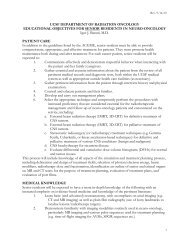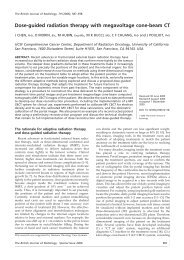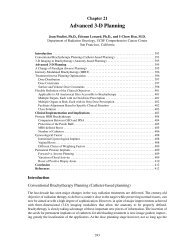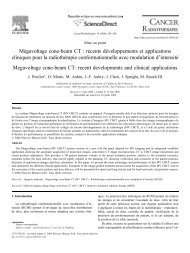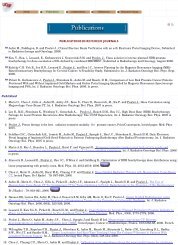Soft Tissue Visualization Using a Highly Efficient Megavoltage Cone ...
Soft Tissue Visualization Using a Highly Efficient Megavoltage Cone ...
Soft Tissue Visualization Using a Highly Efficient Megavoltage Cone ...
You also want an ePaper? Increase the reach of your titles
YUMPU automatically turns print PDFs into web optimized ePapers that Google loves.
The ability of an x-ray imaging system to differentiate soft tissues is affected by the difference in<br />
attenuation coefficient at a given energy between the contrasting objects. For KV CBCT imaging the<br />
contrast changes with energy, because both the photoelectric and Compton effects contributes significantly<br />
to attenuation. For MV energies the Compton effect is by far the dominant interaction process, especially<br />
for material with low atomic number (Z), in which the attenuation coefficient is proportional to electron<br />
density and is nearly independent of Z. Object contrast is therefore constant over a wide range of energies<br />
in the MV regime. Since the attenuation coefficients of KV photons are higher than MV photons in soft<br />
tissue, the percent density contrasts will be easier to detect at KV energies. Thus, while the higher<br />
attenuation of KV photons results in greater transmission losses, it also benefits KV contrast by the squared<br />
ratio of the mass attenuation coefficient for KV and MV energies 1 .<br />
In this paper we present an implementation of a highly efficient MV CBCT imaging system that can<br />
resolve soft tissue contrast with clinically acceptable doses.<br />
2. Methods and Materials<br />
2.1 Timing Interface for <strong>Cone</strong> Beam Acquisition Mode<br />
The timing interface uses the Radiation-on (Rad-on) signal of linear accelerator (linac) to generate trigger<br />
pulses that externally control the frame readout of flat panel imager. In this mode, a-Si sensors integrate the<br />
signal during the radiation interval of each projection and the data readout is performed at the end of each<br />
projection. The detector is set in the external mode. Five trigger pulses (5 frames scan) are sent to the<br />
external trigger input of the flat panel detector prior to the start of first projection to force sensor discharge<br />
by reading 5 frames in absence of radiation. This eliminates the dark current accumulation prior to the start<br />
of the first projection. No readout is allowed during the projection interval. Avoiding readout during<br />
exposure interval improves the image SNR by reducing the effect of the electronic readout noise, and also<br />
removes the linac pulsing artifacts from the image.<br />
Rad-on<br />
Trigger<br />
2.2 Image Receptor<br />
5 Refresh Pulses<br />
First<br />
Projection<br />
Projection period<br />
Second<br />
Projection<br />
Figure-1: Timing Interface for <strong>Cone</strong> Beam Mode<br />
Third<br />
Projection<br />
Data Projection 1 Data Projection 2 Data Projection 3




